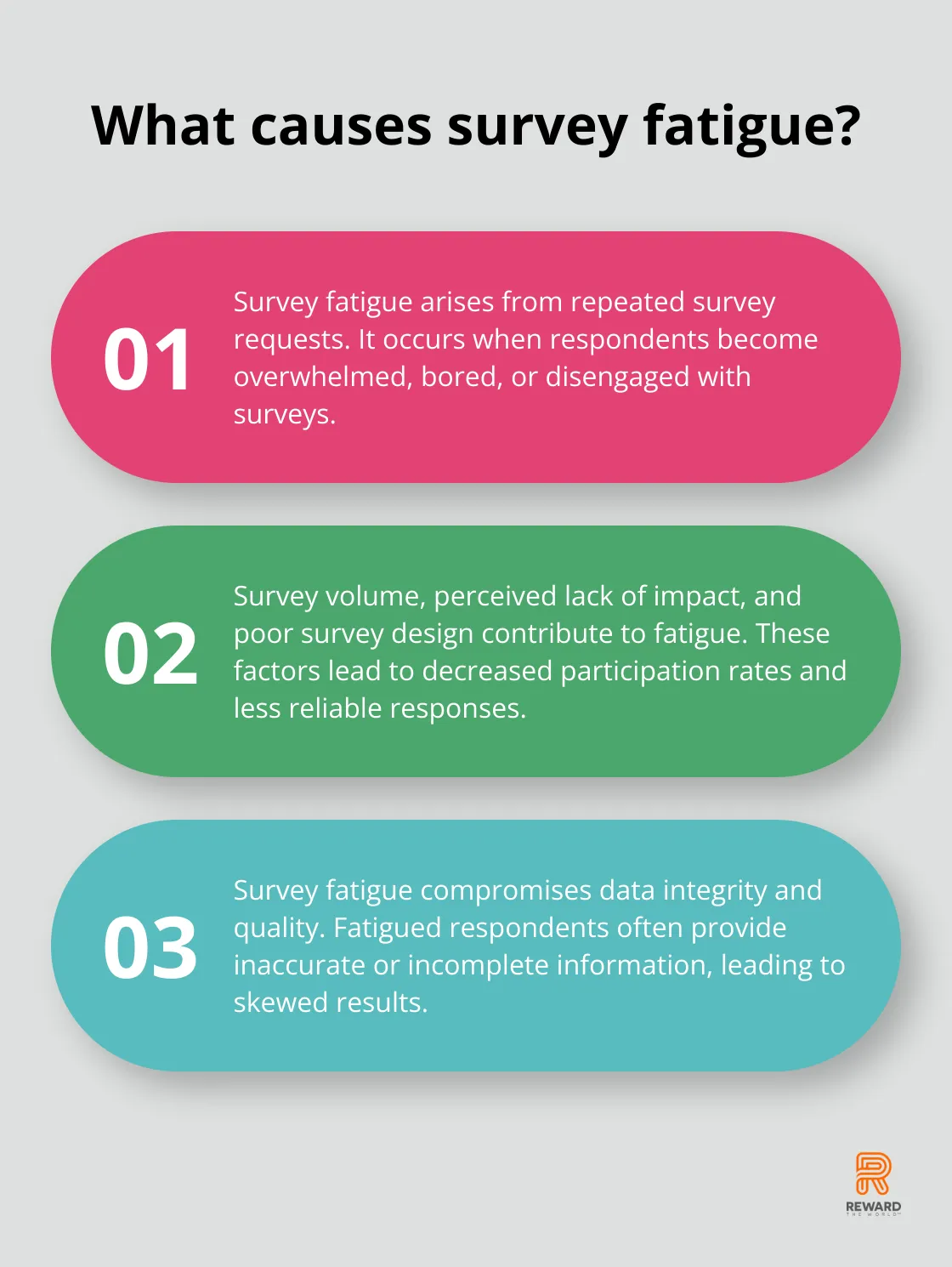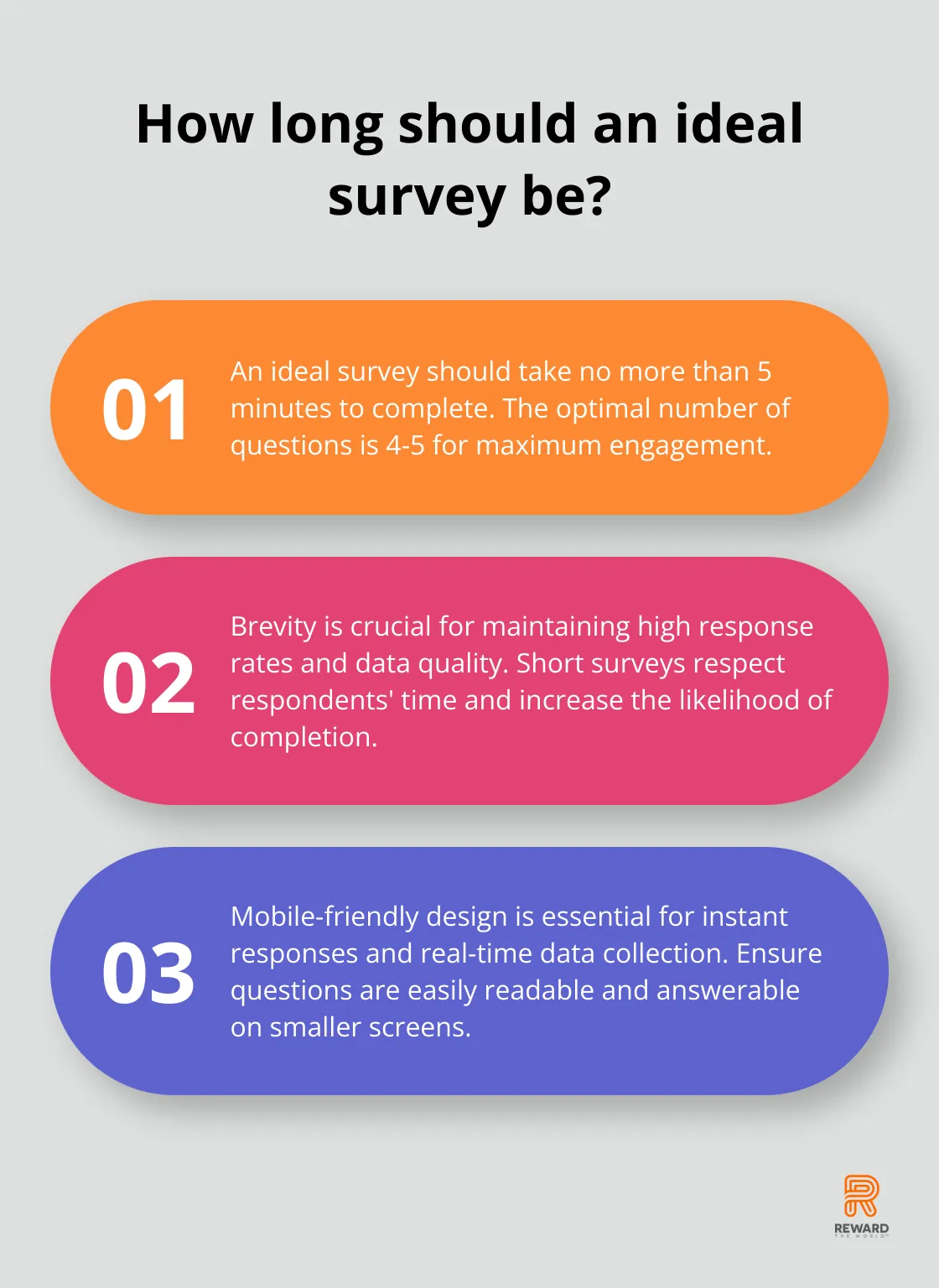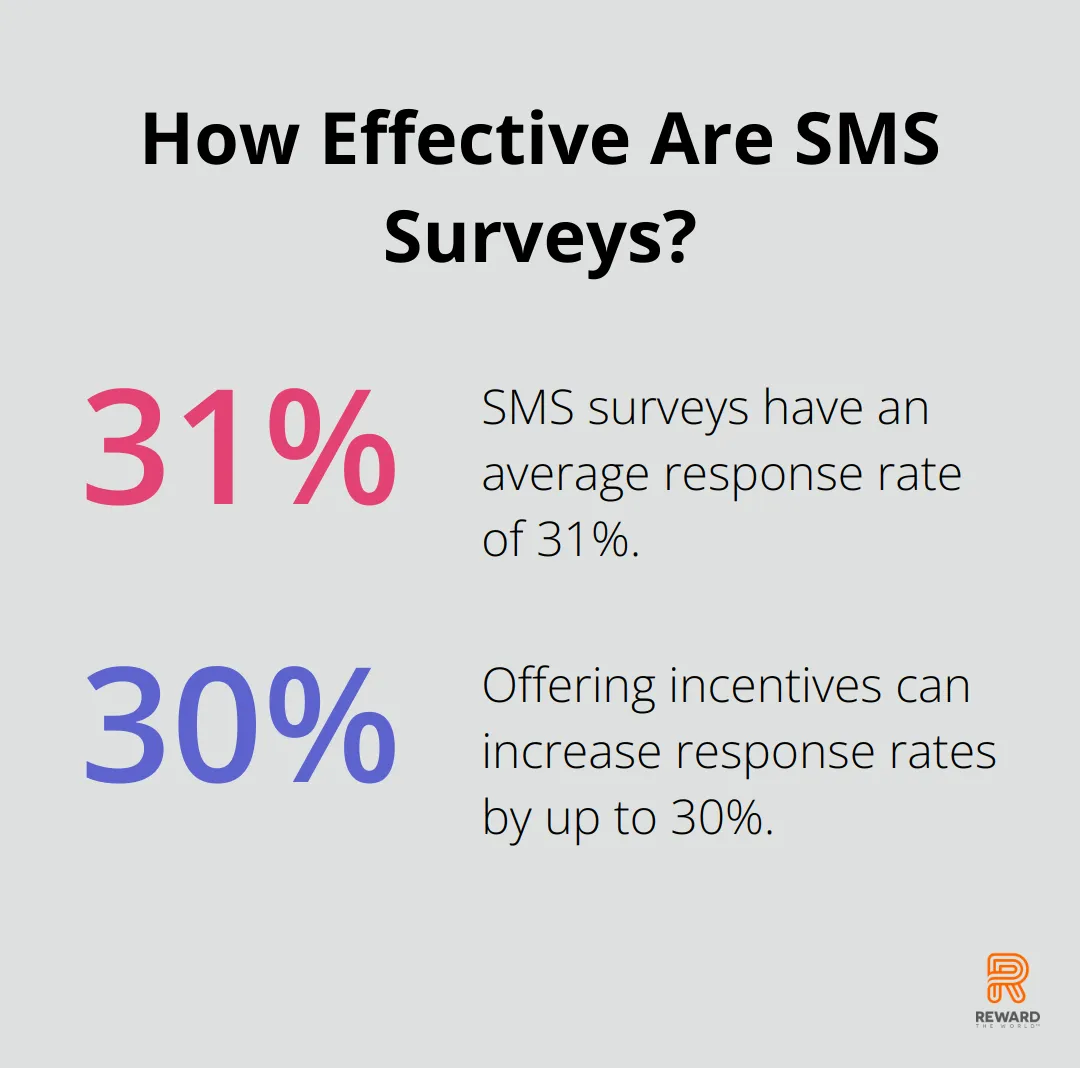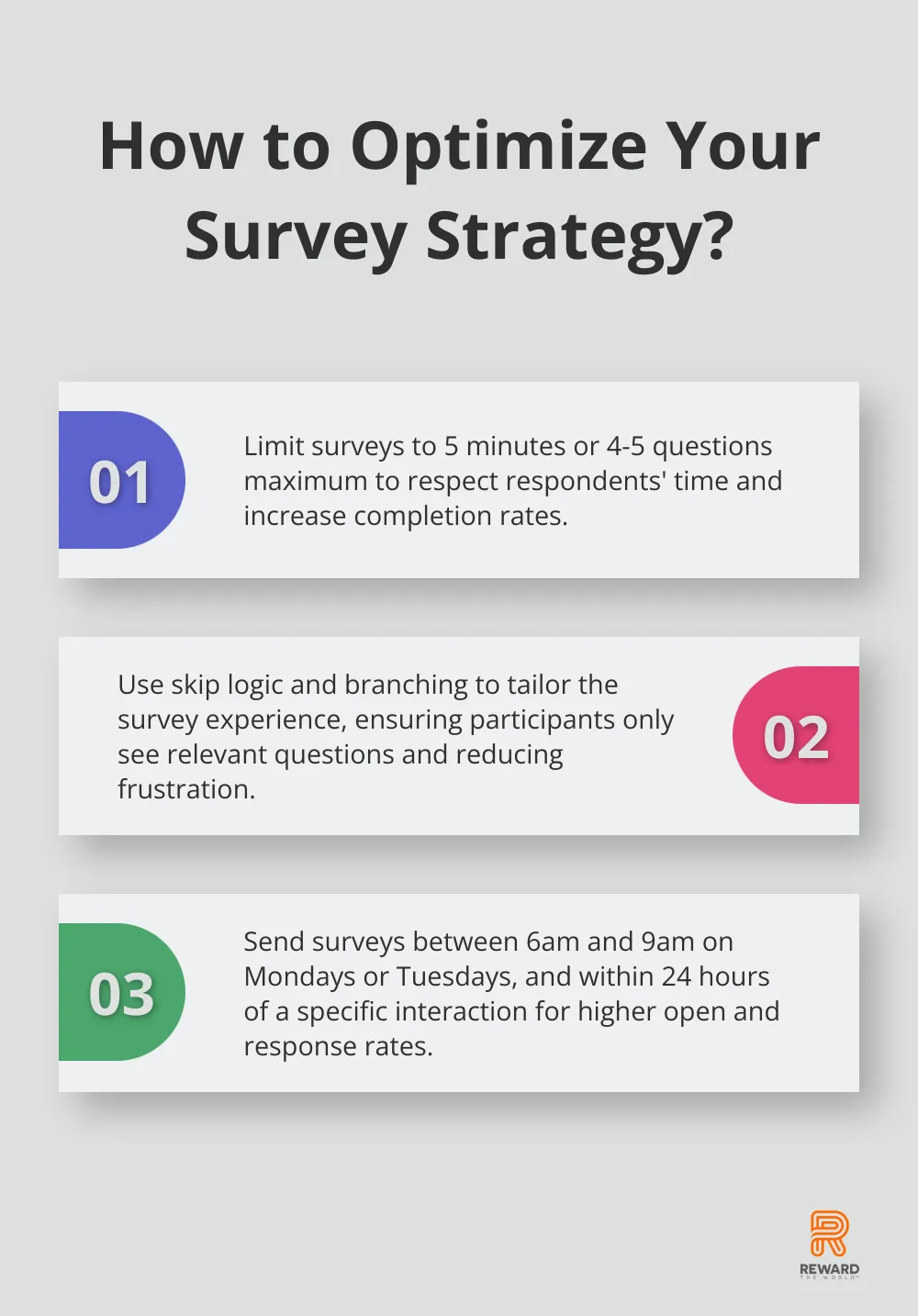
Survey fatigue is a growing challenge in market research, affecting data quality and response rates. At Reward the World, we’ve seen firsthand how this issue can impact the success of research projects.
Survey engagement is key to overcoming fatigue and gathering valuable insights. This post explores effective strategies to combat survey fatigue and keep participants motivated throughout the research process.
What is Survey Fatigue?
Defining Survey Fatigue
Survey fatigue arises when customers are repeatedly asked to engage in surveys, especially if those surveys are lengthy or perceived as irrelevant. This fatigue significantly impacts data quality and occurs when respondents become overwhelmed, bored, or disengaged with surveys, resulting in decreased participation rates and less reliable responses.
Root Causes of Survey Fatigue
Several factors contribute to survey fatigue:
- Survey Volume: The sheer number of survey requests people receive can be overwhelming.
- Perceived Lack of Impact: Respondents may drop out because they don’t believe their responses will make a difference.
- Poor Survey Design: Overly complex, repetitive, or irrelevant surveys quickly lead to disengagement.
Impact on Data Quality
Survey fatigue doesn’t just reduce response rates; it compromises data integrity. Fatigued respondents often provide inaccurate or incomplete information, leading to skewed results and misguided business decisions.
Recognizing Survey Fatigue Signs
Early identification of survey fatigue is essential for maintaining research quality. Common indicators include:
- Declining response rates over time
- Increased survey abandonment (especially towards the end of longer surveys)
- Inconsistent or contradictory responses within the same survey
- Higher frequency of neutral or “don’t know” responses
- Shorter responses to open-ended questions
Effective Strategies to Combat Survey Fatigue
To address survey fatigue, researchers must adopt a respondent-centric approach:
- Keep surveys concise: Try to limit surveys to a reasonable length.
- Use skip logic and branching: Tailor the survey experience to each respondent, ensuring they only see relevant questions.
- Vary question types: Mix multiple-choice questions with open-ended ones to provide a more dynamic experience.
- Time surveys strategically: Send surveys shortly after customer interactions to increase response accuracy.
- Offer incentives: Platforms can help motivate participants and improve response rates.
The next chapter will explore these strategies in more detail, providing practical tips for effective survey design that keeps respondents engaged and produces high-quality data.

How to Design Surveys That Keep Respondents Engaged
Effective survey design plays a key role in combating survey fatigue and ensuring high-quality data collection. Smart strategies can create surveys that respondents want to complete.
Keep It Short and Sweet
Brevity stands as the golden rule of survey design. A good survey response rate is crucial for getting the most out of your surveys. Try to create surveys that take no more than 5 minutes to complete, with 4-5 questions as the ideal target. This approach respects respondents’ time and boosts the likelihood of survey completion.
Leverage Smart Logic
Skip logic and branching in surveys can significantly improve the respondent experience. This technique ensures that participants only see questions relevant to their previous responses, reducing frustration and survey length. Test functionality, logic, and branching to ensure a smooth and efficient experience for your respondents, guaranteeing enhanced data quality for your business.
Mix It Up
Variety maintains engagement. Alternate between different question types such as multiple-choice, rating scales, and open-ended questions. This approach keeps the survey interesting and allows you to gather diverse data. However, use open-ended questions sparingly as they demand more effort from respondents.
Make It Personal
Personalization can dramatically increase survey engagement. Use the data you already have about your respondents to tailor the survey content. This could involve addressing them by name or customizing questions based on their purchase history or demographic information. Personalized surveys show respondents that you value their individual input.
Mobile-First Design
Mobile surveys allow respondents to answer instantly, providing researchers with real-time data and reducing the time lag associated with traditional survey methods. Ensure your survey platform responds well and that questions are easily readable and answerable on smaller screens. Consider using mobile-friendly question types like sliders or single-choice options that are easy to tap.
Test Before You Send
Before launching your survey, conduct a pilot test with a small group. This helps identify any issues with question clarity, survey flow, or technical glitches. Many survey platforms offer robust testing capabilities to ensure your survey performs flawlessly across different devices and browsers.

The next chapter will explore effective strategies for survey distribution and timing, which complement these design principles to further combat survey fatigue.
How to Optimize Survey Distribution and Timing
Smart Audience Segmentation
Effective audience segmentation strategies include demographic segmentation, categorizing respondents by age, gender, income level, and education. Geographical segmentation is also important. This approach tailors surveys to specific audience segments, which increases the likelihood of participation and meaningful responses.

A retail company might segment customers based on their shopping frequency (sending different surveys to frequent buyers versus occasional shoppers). This targeted approach ensures that each group receives questions relevant to their experience, which reduces the risk of fatigue.
Choosing the Right Survey Channels
The channel you use to distribute your survey can greatly impact response rates. Email remains a popular choice, but consider alternatives like SMS, in-app notifications, or even social media platforms depending on your audience preferences.
SMS surveys have an average response rate of 31%, compared to 24.8% for email surveys (according to a SurveyMonkey study). This highlights the importance of choosing channels that align with your audience’s communication preferences.
Strategic Timing
The best times for sending surveys are between 6am and 9am, particularly on Mondays and Tuesdays. Both open rates and response rates are typically highest during these times.
Consider the context of your survey. If you seek feedback on a specific interaction or purchase, try to send the survey within 24 hours while the experience remains fresh in the respondent’s mind.
Judicious Use of Reminders
Reminders can boost response rates, but overuse can contribute to survey fatigue. Send no more than two reminders, spaced about a week apart. Make sure each reminder adds value (perhaps by emphasizing the importance of the respondent’s input or highlighting the survey’s closing date).
Incentivizing Participation
Offering incentives can significantly boost survey participation rates. Reward the World’s platform provides a range of options to motivate respondents, from eGift cards to cash payments. Choose incentives that resonate with your audience and align with the effort required to complete the survey.
A study found that offering incentives can increase response rates by up to 30%. With Reward the World’s diverse reward options, you can tailor incentives to different audience segments, which further enhances engagement.
Monitoring and Adjusting
Continuously monitor your survey performance metrics, including response rates, completion times, and dropout points. Use this data to refine your distribution strategy over time. If you notice declining engagement, adjust your survey frequency, timing, or incentive structure.
Final Thoughts
Survey fatigue challenges market researchers, but effective strategies maintain high survey engagement. Short, focused, and relevant surveys with skip logic and varied question types keep respondents interested. Personalization and mobile optimization further enhance participation rates. Reward the World offers a comprehensive solution for businesses to boost survey engagement with instant rewards (https://rewardtheworld.net).

Timing and distribution play key roles in combating survey fatigue. Audience segmentation allows for targeted surveys that resonate with specific groups. Researchers should choose appropriate channels and send surveys at optimal times to increase response rates. Judicious use of reminders can boost participation without overwhelming respondents.
Continuous improvement in survey methodology is essential for long-term success. Researchers must monitor performance metrics and adjust strategies based on data to maintain high engagement levels. The research landscape evolves rapidly, and approaches to gathering feedback must adapt accordingly. Implementing these strategies helps researchers overcome survey fatigue and collect high-quality data for informed business decisions.
